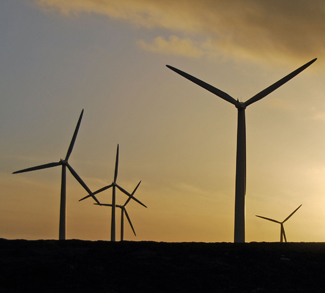Summary
China has gone from the world’s largest polluter to, arguably, the number-one leader in clean energy, and in the process it is achieving a growing dominance in the field of renewable energy. China has surpassed the U.S. as the world’s largest greenhouse gas emitter for a decade now, discharging twice as much as the U.S. as of this year. Now, witnessing the consequences of rapid industrialization, the Chinese government has shifted its priorities from maintaining economic growth to achieving a more sustainable development path. Moreover, this state-business collaboration looks beyond just protecting the environment, hoping to use diversification and investment to transform China from the “factory of the world” to its “innovation hub.”
China is a big investor in the renewables industry both at home and abroad. In 2015, China invested $103 billion in its domestic renewables market, which was two and a half times the amount spent by the U.S. and five times that of the UK. In 2016, Chinese firms invested a record $32 billion in renewable energy and electricity transmission assets abroad, representing a 60% year-on-year increase from 2015 (in deals exceeding $1 billion). This includes a $13 billion acquisition of Brazil’s CPFL Energia SA, an electricity generation and distribution company, by China’s State Grid Corp, as well as a $2.5 billion purchase of a 25% minority state in Chile’s Sociedad Quimica y Minera (SQM) by Tianqi Litihum.
Chinese producers also continue to dominate clean energy production and manufacturing. The country currently boasts five of the six largest solar panel makers in the world. Moreover, five of the top ten wind turbine markers are based in China, not to mention the world’s largest lithium ion manufacturer. According to Greenpeace estimates, China is installing a soccer field’s worth of solar panels every hour as well as one wind turbine in the same time frame. Moreover, a study published in the journal Nature Energy claims that China could generate a quarter to potentially a third of its electricity from wind power by 2030.
The renewables industry provides huge opportunities for investment, technology, manufacturing, and employment. Moreover, the next couple of years will be crucial for countries who want to gain market share in this expanding industry. As such, China’s most recent five-year development plan has incorporated sustainable development into the core of its economic strategy of raising the quality of life for all citizens. According to Tim Buckley, the author of a recent report by the Institute for Energy Economics and Financial Analysis: “At the moment, China is leaving everyone behind and has a real first-mover and scale advantage.” This gap will only be exacerbated if countries such as the U.S., UK, Australia or the EU continue to pump the breaks on clean energy.
Background
To grasp China’s path to dominance in renewables, one must consider the changing dynamics of the market, state, as well as international and civil society:
Global trends reveal an increasing shift towards renewable energy sources, not simply for electricity usage, but also electric vehicles and efficiency technology. Bloomberg New Energy Finance forecasts that global investment in renewable power will grow to $7.8 trillion in the next 25 years, compared to just $2.1 trillion in fossil-fuels over the same period. Last fall, the International Energy Agency (IEA) increased its latest five-year growth forecast for the renewables market by 13% in light of policy support in key countries and sharp cost reductions, particularly in wind and solar energy. Over the forecast period, costs are expected to drop by 25% in solar PV and 15% for onshore wind.
While all countries stand to profit from the declining costs of renewable energy technology, China stands to benefit in particular thanks to its large economies of scale and competitiveness on the global market. As Christopher Dent (2015) notes: “China’s [renewable energy] business across different industry value-chains is characterized by dynamic entrepreneurism, inter-sectoral connections, and a dense mix of state-owned enterprises (SOEs) and private sector companies.” Hence, renewables represent a competitive—and at times overcrowded but optimistic—market, which leads to high levels of productivity and efficiency growth. Moreover, the nature of China’s export-oriented manufacturing sector also helps lower costs of production thanks to big projects supported by government policy and high economic demand.
Worldwide renewable energy power capacity has grown 26% from 93GW in 2005 to 1473GW in 2012. Moreover, China has achieved the fastest growth in its power generation capacity for years, almost tripling its power generation capacity from 122GW in 2005 to 341GW by 2012. The U.S. ranks second at 164 GW, Germany comes in third at 76GW, followed by India at 67GW. Meanwhile, the IEA predicts that China alone will account for 40% of wind energy capacity growth as well as 36% of solar and hydroelectric increases between 2015-2021.
China’s electric vehicle market also overtook the U.S. in 2015 as the largest in the world, with over 200,000 new registrations. China-based BYD and CATL are challenging Tesla’s pre-eminence with the help of China’s Tiannqi Lithium, the largest manufacturer of lithium ion, an important input for electric vehicle batteries. Moreover, companies are also encouraged to develop cost-effective energy-saving technologies, as the state maintains robust national standards for renewable energy technologies to keep Chinese firms up-to-date technically.
The Top-Down Model: Chinese Government Efforts in the Renewables Field
China’s National Energy Administration has a clear strategy to dominate one of the world’s fastest growing industries. At the start of this year, the Chinese government declared its plan to spend more than $360 billion in renewable energy over the next 3 years, stating how the sector will help create more than 13 million jobs by 2020, curb greenhouse gas emissions and reduce smog in urban areas.
Three main reasons that the government has devoted attention to the renewable energy sector include the need to address energy security challenges, promote environmental and welfare imperatives as well as capture markets shares in strategic and expanding industries. There is high demand for energy in China due to its industrial-based development. As the largest importer of energy in the world, investing in renewables will help ameliorate supply and price risk, not to mention, environmental damage and the concomitant risk of social unrest.
China has instituted hydropower policies for many decades, but it wasn’t until the 1990s that the government started to pursue a multi-sector renewable energy policy. As the Chinese economy matured, new approaches to national economic and social development emerged. In particular, one of the core aims announced in the ‘scientific development concept’ established by President Hu Jintao was a resource-saving and environmentally friendly ‘harmonious society,’ thus shifting its attention from GDP growth to balanced growth. This vision was ratified into the national constitution at the 17th Party Congress in October 2007, and has been featured prominently in the 12th and 13th five-year-plans.
The Chinese government uses a mixture of policy instruments to reach its renewable energy goals, including regulatory mandates, direct financial support, and market-based instruments. Moreover, the scale of China’s policies, strategies, and investments remains unrivalled. Beijing is set to implement the world’s largest emissions trading system, further expanding seven pilot carbon trading systems to the nation level. If prices are high enough, this program could create strong incentives worldwide. The government is also experimenting with innovative financial vehicles to finance low carbon transition, and its green bonds market could potentially deliver up to $230 billion in investment in renewables over the next five years.
Still, pollution as a result of the country’s expanding energy appetite is a tangible problem that the government faces. Coal is the known source of an estimated 40% of the most dangerous pollutant particle present in the country’s air, and the central leadership is taking this into serious consideration in response to public outcries (poor air quality is linked to 1.6 million deaths yearly). China recently set a target to limit coal to 58% of the energy mix by 2020, down from 64% in 2015. However, it has made no specific announcement of a target to curtail its coal consumption, which remains its largest source of energy (70%) and accounts for half of the world’s coal consumption.
Nevertheless, the country’s clean energy program sets the stage for a gradual shift away from coal dependence. Buckley contends that the global trend towards renewable energy sources is “a technological shift that is unstoppable,” but he believes that government policy can affect this pace of change. China’s coal use fell for a third straight year in 2016.
International Cooperation and Competition over Renewables
While addressing the United Nations in Geneva and the World Economic Forum to bolster China’s image as a dedicated and dependable climate leader, President Xi warned “there is only one Earth in the universe and we mankind have only one homeland,” he continued by reminding how the “Paris agreement is a milestone in the history of climate governance” and that “we must ensure this endeavor is not derailed.” For its part, China formally committed to halting the rise of its carbon emissions by 2030. Meanwhile, signatories of the Paris accord agreed to keep global warming to no more than 2C above pre-industrial levels, as the agreement entered into force November last year.
However, President Trump’s shock election and threat to pull the U.S. out of the deal has thrown US climate change policy into doubt. The head of the Environmental Protection Agency (EPA), Scott Pruitt, is a known climate change skeptic. And if this trend persists, the U.S. will certainty continue to lose out to China in the global renewables industry. There’s another important fact to consider here: China’s increasing dominance in the renewables supply chain could create even further disincentives for the U.S. and other countries to invest in clean energy options down the road, as they will have lost any opportunity for competitive advantage and/or the positive employment outcomes of investing in renewables production.
Europe’s clean energy industry and policymakers who have made significant gains in the global green energy race over the first half of the decade are not only facing increasingly stiff competition, but also regional instability. Oliver Joy, a spokesman for the trade body WindEurope remarked how “global investment in renewables reached record levels last year and yet Europe saw a 21% decline.” As the region continues to recover from the Eurozone crisis, China has pulled ahead as a new leader in clean energy.
Still, China is reluctant to be the “sole leader” on climate change. As a developing country facing pollution issues and an economic recession of its own, China certainly isn’t eager to become the new designated protector of the global commons. That being said, the state has been an important instigator of huge increases in foreign investment last year. Moreover, the Asia Infrastructure & Investment Bank—a China-led international financial institution akin to the West-led World Banka and IMF—is a key facilitator in this process. And the BRIC’s New Development Bank made its first loans all in renewable energy. R&D funds are essential to improving technology and lowering costs and the Chinese government has welcomed diversification into developing countries.
Conclusion
In the past decade or so, China has transformed into the world’s largest manufacturer and exporter of clean energy products. Rising public and private sector interest has helped drive the burgeoning growth of the nation’s renewable energy production, making China one of the biggest investors in renewable energy development. By the numbers, China’s dominance stacks up in all sectors—wind, solar and hydro. Further, Beijing has a clear strategy to control the renewables industry, just as it did with the rare earth minerals market. In recognition of an alternative path for growth which is cleaner, more efficient, and innovative, China has not only helped augment its economic position but can now also be recognized as a climate champion.




